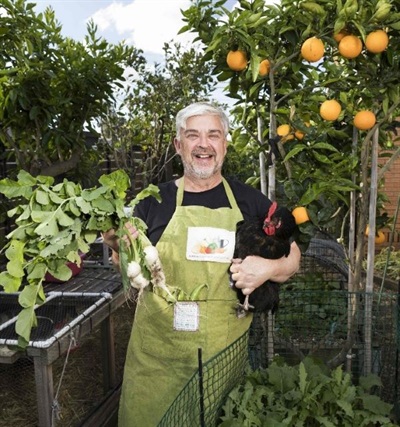“Growing food is a conversation starter and now people stop me in the street to say hi”

The first My Smart Garden event I went to was a hands-on edible garden working bee in Altona North. I’m a real estate agent so I only have one day off a week, but I was there for five hours and I loved the idea of everyone working together. Talking to Council at the event gave us the encouragement to set up the Altona Community Garden group.
My garden is only 120m2 but now I’ve got 33 fruit trees, which includes several varieties of nectarines, peaches, mandarins, plus an orange, Satsuma plum and Tahitian lime. Through the program I’ve gotten to know local fruit tree expert Craig Castree whose advice has helped me keep them small but productive. As well as the fruit, our garden makes a huge difference to the comfort of the house. Because of a west facing brick wall, it gets so much heat in summer and then takes so long to cool. Now I have a grape on a trellis that shades the wall in summer and loses its leaves in winter.
It’s October now and for the next four months I won’t need to buy any greens, tomatoes, capsicums or spring onions from the shops. My strawberries will hit production soon and I’ll get a punnet a day from 15 plants. In the old days you’d only have strawberries from December to January. It uses so much more energy to grow them in greenhouses under lights, and transport them from two thousand kilometres away. We would make much less of an impact on the environment if we could eat seasonally and locally.
Soil health is important because the plants just thrive and I don’t have to use chemical fertilisers or pesticides anymore. My grandad loved to grow roses and he would fill a drum with seaweed to make his own fertiliser – but it used to stink! I use seaweed as a mulch instead. It goes crispy on the top which deters slugs and snails, but underneath the soil is alive with worms and it doesn’t smell.
Last year I started a garden on my nature strip. Everyone said people will vandalise it, but no one has. I meet about three people every week. Growing food is a conversation starter. The Italians will say “ahh it’s like my Nonna’s garden in Italy!” People know me now and I leave our gate open so they drop in and say hi. Over summer we grow 100kg of zucchinis, and people will stop me in the street and say “I’ve just picked a few zucchini and I’m going home to make a slice”. They drop me off relish or whiting they’ve just caught – it’s really started that barter. Recently I grew Japanese white radish, fennel, beetroot and borage. The biodiversity they attracted was fantastic and in one spot there would have been 50 bees and 100 ladybirds.
I sometimes host My Smart Garden tours. They’ve been brilliant and the last one booked out so quick! I’m not a horticulturalist, I’m just a bloke who loves gardening, but now I’m giving advice to other locals. I really enjoy sharing knowledge and I want to do more. I gave the kids cherry tomatoes with a little flake of salt and I loved the look on their faces! I remember when supermarkets used to have food like that. In a garden you can grow varieties that have nearly been lost. If we don’t grow them and save seed, in a 100 years’ time we’ll lose that diversity, and have only the boring types that travel well and look good.
The Altona Community Garden group has an arrangement with the local cafe, Bezirk. We introduced them to a local who grows oyster mushrooms on coffee grounds and then we get it as a compost which is better for the soil. Now they never put any coffee grounds in their rubbish, and it’s improving our soil and stopping us buying sugar cane mulch that is trucked down from Queensland.
The My Smart Garden program has been a link to meet other people and to get awareness out there, and I hope that our community garden can work with the program to share this important knowledge.